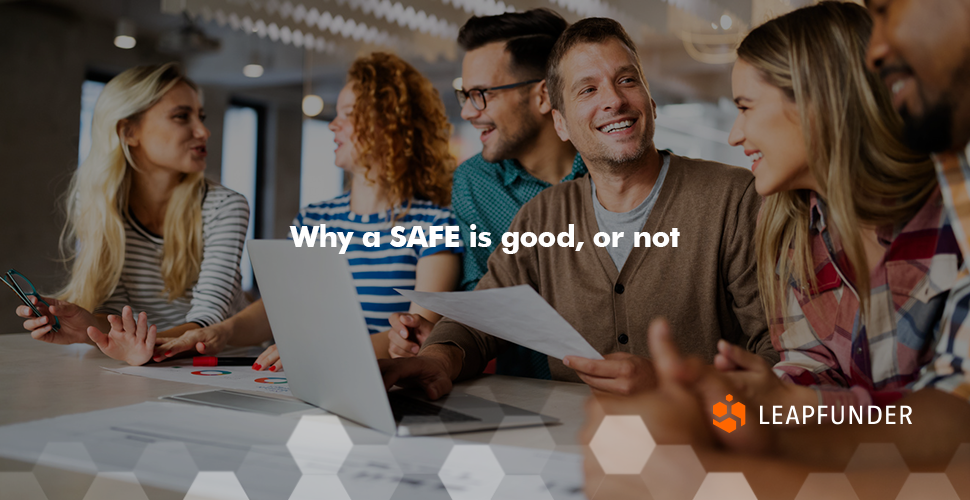In late 2013, the startup incubator and accelerator Y Combinator introduced the simple agreement for future equity (SAFE) to unify the terms for startup financing and simplify the fundraising of their startups. A SAFE has no maturity date so it can never lead to a cash crunch for the startup. That makes it safer than old-fashioned convertibles that require a cash repayment on expiry. This contract template generated a lot of publicity and is used in California a lot.
But is it a good choice for your startup?
Usually not! Some very specific conditions in the SAFE make it a good fit for the situation of the Californian startups that it was developed for… but unsafe for a lot of others. Since the appearance of the SAFE, there have been more developments, and there are modern convertibles that work better in most situations in Europe. Let us explain.

Some features of a SAFE:
- A SAFE counts any share issue, no matter how small, as a qualifying event
Example of an implication: that means that if you give a % of your company to an accelerator program – in return for a small amount of cash pocket money for example – then that may still be a qualifying event for your SAFE. And that means that the artificially low cash valuation of those shares will be used for converting the other investors into shares also.
- A SAFE does not specify a pooling structure for your small investors
Example of an implication: in Europe, it is common to have many smaller shareholders. European angels invest smaller tickets, and VC rounds are less common generally. Since there are more angel investors per round, and more angel rounds over time you will find yourself with a lot of angel investors on the cap table. To keep that situation manageable there must be a high-quality pooling vehicle to manage those investors. And that should be agreed up-front in the initial convertible contract. Without that, your cap table could become a mess, and that will scare off future investors.
- A SAFE can run forever, in principle, and without interest
Example of an implication: if your startup becomes profitable through organic growth it will never have to do another equity funding round. In that situation the SAFE will simply never convert… and the investors will never get their shares. Since there is no interest their investment doesn’t even go up in value. That’s unreasonable.
- Some versions of the SAFE specify the cap on the ‘post-money’ valuation – which is defined as the valuation after conversion of all convertibles, options, etc. – instead of the pre-money valuation
Example of an implication: the ‘post-money’ valuation in this definition is dependent on the size of the convertible funding rounds that preceded or followed the SAFE round. If other convertible rounds also convert they will together make up the post-money valuation, which is capped. A post-money cap is therefore more likely to be exceeded, and with each funding round the likelihood increases. In effect, with each later funding round, you are thereby lowering the cap ceiling and therefore the expected conversion valuation of the earlier rounds, and that could be very costly if the SAFE runs for years and there are a lot of convertible funding rounds before it finally converts. In Europe that is actually very common.
All in all a SAFE makes sense if:
- You strongly expect the very next issue of shares to be a major priced equity funding round. So you expect that round very soon, ideally within months
- You expect < 3 angels in the SAFE round and therefore don’t care about pooling
- You and your investors intend to shut the company anyway if there is no major priced equity funding round soon, and so the SAFE won’t run forever anyway
- You know the SAFE funding round will be the only funding round prior to the major priced equity funding round, so that there are no later funding rounds effectively lowering the cap
That situation 1-4 doesn’t happen very often in Europe. And so in Europe, startups should normally use a modern convertible. This has the alternative properties:
- Only a share issuance of new shares for a cash investment above a certain threshold amount will count as a qualifying event
- The conversion is agreed into an investor pooling vehicle, and that has been agreed in the convertible contract
- There is a reward for delayed conversion in the form of a non-cash interest on the initial investment. There is a final conversion date that triggers conversion automatically if no qualifying event occurs for years
- The cap is defined on the pre-money valuation and is therefore not affected by the size of later funding rounds
Of course the SAFE changes from time to time. It is worth checking what the conditions are of the latest iteration.
Sometimes we see startups taking a SAFE template, and changing it with a local lawyer into something similar to a modern convertible. That is rarely successful. Better to find a high-quality template for a convertible to begin with.
There are many sources online for a sensible modern convertible or you could just ask an experienced lawyer. Leapfunder provides online checklists and training.
Join our network of startups & investors!
